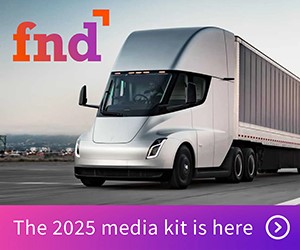Researchers at Chalmers University of Technology in Sweden say electricity cheaper than diesel for heavy goods vehicles
The Chalmers researchers now hope that their results will accelerate the transition from diesel to electricity in heavy goods vehicle transport
In the past, it was considered unprofitable to electrify heavy goods vehicles that transport cargo over long distances. But now researchers at Chalmers University of Technology in Sweden have shown that it can be cheaper to run heavy goods vehicles on electricity than on diesel.
‘I myself am surprised by the results and hope that more haulage companies and heavy goods vehicle manufacturers will be willing to invest in electrification now that we have shown that it can be cost-effective,’ says Johannes Karlsson, Doctoral student in Automatic Control Engineering at Chalmers.
The transition from a fossil-fuelled to an electric vehicle fleet has so far been most visible in lighter vehicles, such as private cars and delivery vans. In the case of heavy goods vehicles (HGVs) travelling long distances, the transition has been slow because the prevailing view is that such vehicles would need large batteries, which take up so much load capacity that electric operation is not profitable. But now researchers at Chalmers University of Technology have found that electricity can indeed be a cheaper alternative to diesel – even for heavy goods vehicles.
“We have looked at a scenario where heavy goods vehicles drive the 553 kilometres between Helsingborg and Stockholm in Sweden. We have compared two different battery sizes and two possible prices for fast charging. Our conclusion is that it seems possible to electrify this type of vehicle in a cost-effective way,” says Johannes Karlsson.
Study based on real-world data
In the study, the researchers created a model based on data from a real haulage company in the town of Helsingborg, which was chosen because it can be considered to have typical tasks and operating conditions for a haulage company in that part of Sweden covering long distances. The large battery did not need to be recharged on the road, only at the company’s own depots, but it did take up more load capacity. The smaller battery needed quick charging on the road but did not restrict the load capacity as much. The results showed that running on electricity was profitable for the haulage company in the study.
“With the right battery size, it should be possible in many cases to electrify heavy goods vehicles so that the cost is the same or lower than if the they were powered by a diesel engine. The best size of battery is determined by whether light loads are being transported, such as parcels or vegetables, or heavy loads, such as drinks or timber. Other important factors that influence the choice of battery size are driving patterns and the price of fast charging. A realistic future scenario is that HGVs will have different battery sizes,” says Johannes Karlsson.
Investing in batteries and charging equipment comes at a cost. To make the investment worthwhile, researchers have shown in a previous study that the battery of an electric HGV needs to be charged and discharged at least 1,400 times, which is something that most commercial vehicles exceed in their lifetime.
Hoping to accelerate transition
Studies of the kind conducted by Johannes Karlsson and his colleague Anders Grauers are unusual. In the past, the electrification of heavy goods vehicles has mainly looked at scenarios where the HGVs move and are charged within a confined area, such as a harbour. The Chalmers researchers now hope that their results will accelerate the transition from diesel to electricity in heavy goods vehicle transport.
“We have shown that a heavy goods vehicle fleet can be electrified in a cost-effective way. This should lead to companies having the incentive to invest in the transition. Financial incentives usually mean that changes can be made quickly, and our study is realistic for many transport operations,” says Anders Grauers, Associate Professor at the Department of Electrical Engineering at Chalmers.
More about the study:
The price of diesel was set at €1.20 per litre and the price of fast charging at €0.17 per kilowatt hour or, alternativley, €0.40 per kilowatt hour. The prices are stated excluding VAT. Otherwise, the researchers assumed that costs such as maintenance were the same for the HGVs regardless of whether they ran on electricity or diesel.
The model used in the study is based on data from a haulage company with realistic conditions and tasks. Although the researchers had assumed a low diesel price, the study concluded that it is profitable for a haulage company to electrify its fleet of HGVs, with the exception of vehicles that mostly load up to their maximum allowed weight.
The study, ‘Case Study of Cost-Effective Electrification of Long-Distance Line-Haul Trucks’, was published in the journal Energies and was written by Johannes Karlsson and Anders Grauers. The researchers work at Chalmers University of Technology.
The research was carried out in collaboration with the Swedish Transport Administration and Volvo Trucks and was financed by the Swedish Transport Administration.
Category: Electric Vehicles, Engines & Drivetrains, Equipment, Featured, Fleet Diagnostics & Software, Fuel & Oil, General Update, Green, News, Shop Stuff, Tech Talk, Transit News, Vehicles











